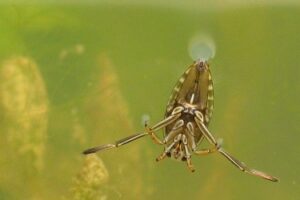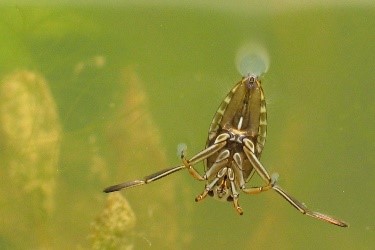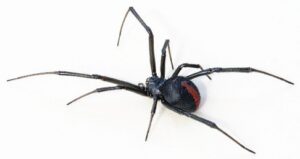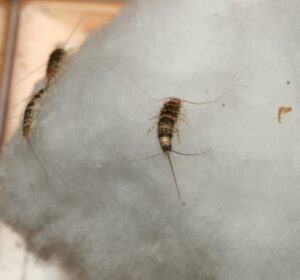Backswimmers:
Common Backswimmer
General Description
| · The most easily identifiable feature of notonectids is their long hind legs that are used to propel themselves in the water.
· Adults have pale tan heads and legs. The pronotum is darker than the head and the elytra (hardened forewings) can be a range of tan colors. |

Credit: Holger Gröschl |
- Females have a larger body size compared to males.
- The eyes are large and dark red in color.
- Fully-grown adults measure about 16 mm.
- Eggs have white oblong eggs and are found attached to aquatic vegetation.
- Nymphs look like small adults. They do not have fully developed wings as nymphs, and they have much shorter abdomens. They are often more uniform in color and their pronotum is not darker than the rest of the body, as seen in the adults.
Life Cycle and Common Characteristics
- It is a species of aquatic insect
- These water insects swim and rest on their back or upside down (hence their common name “backswimmer”) and are found under the water’s surface.
- Adults lay eggs in the fall and or spring.
- They have five nymphal instars that develop over the summer months.
- It supports itself under the water’s surface by using its front legs and mid legs and the back end of its abdomen and resting them on the water’s surface.
- Although they live in the water, they breathe atmospheric air and do not have gills.
| · When they are diving or resting under the water’s surface, they create a film of air that surrounds their body.
· Males and females both spend a lot of time on the surface of the water where they encounter mosquito larvae. · Mature females dive to the bottom of the pond to feed on isopods, but only in shallow waters. |

Credit: E. van Herk |
- Mature females have a larger abdominal size, which could support a larger air bubble and allow them to remain submerged for longer.
- They inhabit still freshwater, e.g. lakes, ponds, and marshes, and are sometimes found in garden ponds and even swimming pools
- There is only one generation a year.
Damages and Economic & Medical Implications
- They can inflict a painful “bite” on a human being, actually a stab with their sharp tubular mouthparts (proboscis).




